Past Exhibitions
23rd April 2024 until 23rd June 2024
Opening hours: Open Daily 10:30 - 4pm except Mondays
The Sunbury Embroidery Gallery
Group: South East of England (UK)
9th September 2023 until 28th November 2023
Whitchurch Silk Mill, 28 Winchester Street, Whitchurch, RG28 7AL
Opening hours: Tue - Sun & Bank Holidays 10:30 until 5:00
https://whitchurchsilkmill.org.uk/
Group: South East of England (UK)
Earth Threads
at Whitchurch Silk Mill
Earth Threads is a touring exhibition, starting at the historic Whitchurch Silk Mill in September 2023 and continuing to the Sunbury Embroidery Gallery in 2024. The exhibition will reflect the heritage and tradition of weaving and will raise awareness of the range and potential of weft-faced tapestry weaving as a form of artistic expression. It will show how woven tapestries can be both beautiful and thought-provoking.
Earth Threads 2023/2024
Earth Threads is a touring exhibition of contemporary weft-faced woven tapestries. It is the sixth biennial exhibition of the British Tapestry Group (BTG) South East Region. All members of the South East Region were invited to submit a woven tapestry to this exhibition. Earth Threads showcases and celebrates these vibrant and original tapestries from weavers of all levels of experience. The exhibition opens at the historic Whitchurch Silk Mill in Hampshire and then travels to the Sunbury Embroidery Gallery in Sunbury-on-Thames.
The theme Earth Threads was chosen to be both broad and inspiring. The natural world provides a great source of visual beauty and variety which we can celebrate. It is also challenged by climate change, pollution, and the loss of biodiversity. The theme leads to many different viewpoints and each weaver interprets the theme in their own way.
As a medium, woven tapestry provides an extensive toolbox of materials and techniques. Natural materials such as silk, nettle, linen, cotton, and wool are available in many different colours and thicknesses. Recycled or reclaimed items and other materials such as paper, wire, fishing line and lurex can also be used. These materials can both surprise and challenge the viewer.
The exhibition aims to excite and educate both the weaver and the visitor to what is achievable in woven tapestry using original designs, colours, materials, and techniques. Woven tapestries can be both beautiful and thought-provoking, expressing the direct beauty of nature or the challenges of climate change. This exhibition is a showcase of diverse and original tapestry weavings that respect the heritage and traditions of tapestry weaving and celebrate the joy of weaving to the theme of Earth Threads.
It is a privilege to show the Earth Threads exhibition at the historic Whitchurch Silk Mill in Hampshire and at the Sunbury Embroidery Gallery located in the 18th century Walled Garden at Sunbury-on-Thames. We are very grateful for the support of the teams from both venues for promoting contemporary tapestry weaving and making it accessible to a wider audience.
British Tapestry Group South East Exhibition Team
2nd June 2023 until 29th June 2023
Dunblane Museum: The Cross, Dunblane, Stirlingshire. FK16 0AQ
Opening hours: Mon, Tue, Thu, Fri, Sat 10:30 am - 4:30 pm - Free entry
https://dunblanemuseum.org.uk/?exhibition=british-tapestry-group
https://dunblanemuseum.org.uk/getting-here/
(what3words locator) - grandson.ounce.colder
Group: Scotland (UK)
Under the Influence
Members of the BTG Scottish Region exhibiting recent works will be around most days demonstrating tapestry weaving in the museum gallery and are happy to speak about their work and influences.
Image credits: Louise Oppenheimer, Veronica Collins, Angela Waterworth, Lyn Dunnachie, Sabine Hyland and Siobhan Ratchford.
2nd April 2023 until 29th April 2023
The Paxton Centre 52 Anerley Hill, Crystal Palace, SE19 2AE
Opening hours: Sun - Sat (every day) 10 am - 5 pm – Free Entry
Private view: Friday 7 April: 7 - 10 pm
https://www.thepaxtoncentre.co.uk/
Group: London (UK)
Woven Worlds
contemporary tapestry art
An exciting and varied exhibition of woven tapestries by members of the BTG London Regional group. The title ‘Woven Worlds’ reflects the diversity of weaving techniques and offers examples of work from artists at different levels in their career. A few of the exhibits are displayed in a set to illustrate the title.
|
Participating artists Amanda Saunders, Aruna Reddy, Barbara Byrne, Bridget Lane, Chris Arscott, Christine Eborall, David Stokes, Eleonora Budden, Jackie Bennett, Jacky Boxall, Joan Kendall, John Barron, Justine Randall, Lee Jenner, Lucy Sugden, Lyn Bainbridge, Margaret Appa, Marion Borthwick, Stephanie Edwards and Suzanne Osborn. More information about the artists on
|
The Paxton Centre 52 Anerley Hill Crystal Palace, SE19 2AE Dates: 2 to 29 April 2023 Hours: Mon – Sun 10am – 5 pm Open evening: 7 April 7 – 10pm Workshops Sun 16 April 2 – 4pm by Lucy Sugden Sat 22 April 1:15 – 3:45pm by Jackie Bennett Limited places, please book in advance: https://www.thepaxtoncentre.co.uk/ |
Demonstrations Sat 2 April 2-4pm Sat 8 April 2 – 4pm Mon 10 April 10am – 12 Sat 15 April 10am – 12 Sun 16 April 10am – 12 Sat 22 April 2 – 4 pm Sun 23 April 2 – 4 pm Sat 29 April 2 – 4 pm Free, drop in, no booking required. |
9th May 2022 until 15th May 2022
Jubilee Library, Jubilee Street, Brighton. BN1 1GE
Group: South East of England (UK)
A Pick of Woven Tapestries
An exhibition of small-format tapestries designed and handwoven by members of the British Tapestry Group South East Region.
The works will be displayed at the Jubilee Library, Jubilee Street, Brighton. BN1 1GE.
It will be open Monday, Tuesday and Thursday from 10 am to 7 pm, Wednesday, Friday and Saturday from 10 am to 5 pm and Sunday from 11 am to 5 pm.
Image credit: 'Heavens' Embroidered Cloths' by Yvonne Dedman
5th January 2022 until 27th March 2022
Farfield Mill, Garsdale Road, Sedbergh, Cumbria LA10 5LW
Opening hours: Due to any ongoing restrictions please see the exhibition venue's website for up to date information about opening times.
Group: National
Threads in Sheds - 2022
Travelling to Farfield Mill, Cumbria
Threads in Sheds is our latest exhibition where we aim to promote woven tapestry as a contemporary art form.
Thirty Six full members of the British Tapestry Group from all regions and nations of the UK and international members have created new tapestry weavings which reflect the heritage and traditions of weaving and shows contemporary weft faced tapestry weaving at its best and most innovative including all styles of weaving, figurative, three-dimensional, contemporary and styles we are yet to experience.
The title “Threads in Sheds” references the technical term in weaving where the weft thread is placed in-between the warp threads as well as the historical building where weaving takes place.
To reflect the historic silk mill where the exhibition opens all the work includes a significant element of silk.
Image credit: 'Twenty Shades of Silk’ (work in progress) Anne-Kirsti Espenes
14th January 2022 until 27th February 2022
The Scottish Ornithologists’ Club; Waterston House, Aberlady, East Lothian, EH32 0PY
Opening hours: Wed - Sun (10-4) – Free Entry
The Scottish Ornithologists’ Club
Group: Scotland (UK)
To the Waters and the Wild
Tapestry inspired by nature from the Scottish members of the British Tapestry Group
The title of the exhibition, a verse from a WB Yeats poem, evokes the escape to be found in the natural world. If this was sometimes curtailed over the past couple of years, we have all learned to value it even more. Like many of us, the artists rediscovered their immediate environment, the local wood, the beach, the bird songs, and found inspiration there, or they looked inwards for memories of encounters with the wild further afield. The result is a small survey of tapestry today and a woven tribute to Nature.
The exhibition is accompanied by sculptures by Chris Hindley.
18th May 2021 until 31st January 2022
Kirkleatham Museum, Redcar, TS10 5NW
Opening hours: Tuesday – Sunday, 10:00-17:00. Free entry but booking required. Last entry 4pm
Group: North of England (UK)
Fabric of the North
Tapestries showcasing the landscapes, industry and social history of Northern England
This stunning exhibition mixes regular and 3D tapestries, large and small, mounted and unmounted, traditionally woven and mixed-media, but all on one theme: our northern heritage.
The exhibition is curated and managed by northern members of the British Tapestry Group. Visitors will enjoy a range of works, from small try-outs by recent beginners all the way through to magnificent pieces by top-class commissioned artists. Tapestry works and weaversbazaar yarns and equipment will be available to buy.
Entry is free but booking is required. Last entry 4pm. Telephone 01642 479500
For more information contact: Sally Reckert
BTG Woven Art website - where you can also see a short video - 'Living Local: Cutting-off a tapestry from the loom'
11th September 2021 until 21st November 2021
Whitchurch Silk Mill, 28 Winchester Road, Whitchurch, Hampshire RG28 7AL
Opening hours: Due to any ongoing restrictions please see the exhibition venue's website for up to date information about opening times.
Group: National
Threads in Sheds - 2021
Opening in Whitchurch Silk Mill, Hampshire
Threads in Sheds is our latest exhibition where we aim to promote woven tapestry as a contemporary art form.
Thirty Six full members of the British Tapestry Group from all regions and nations of the UK and international members have created new tapestry weavings which reflect the heritage and traditions of weaving and shows contemporary weft faced tapestry weaving at its best and most innovative including all styles of weaving, figurative, three-dimensional, contemporary and styles we are yet to experience.
The title “Threads in Sheds” references the technical term in weaving where the weft thread is placed in-between the warp threads as well as the historical building where weaving takes place.
To reflect the historic silk mill where the exhibition opens all the work includes a significant element of silk.
Image credit: 'Twenty Shades of Silk’ (work in progress) Anne-Kirsti Espenes
17th May 2021 until 29th May 2021
Haslemere Educational Museum, 78 High St, Haslemere, GU27 2LA
Opening hours: Open daily (except Sundays) 10 am to 4 pm
Private view: To be arranged.
Directions to Haslemere Educational Museum
For more information contact Mike Wallace
Groups: London (UK) and South East of England (UK)
Window on Weaving
Now on permanent display in our Online Exhibition space
Opened 17th May2021!
The exhibition is organised by BTG SE, and the BTG London Group have been invited to participate. The work exhibited is an expression, both of the diversity of the weavers who created the pieces on display, as well as demonstrating the vast potential of the techniques involved. One of the key factors in bringing the group together has been the nurturing of confidence alongside developing the skills of weaving, and the work on display illustrates confidence and skills in abundance. The exhibition title was chosen to leave maximum scope for interpretation by individual weavers. Only a maximum size was specified.
There will be weaving demonstrations as well as yarns and weaving equipment for sale in a pop up shop on 21st & 22nd May.
“Tapestry: A Twentieth Century Renaissance”, a talk by Margaret Jones, weaver, curator and tutor who exhibits internationally and has won prizes for her work, takes place on Friday 21st May. See Haslemere museum website for details.
30th October 2019 until 3rd January 2020
Farfield Mill, Garsdale Road, Sedbergh, Cumbria, LA10 5LW
Weaving Water – Woven Lands exhibition website
Groups: North of England (UK) and Scotland (UK)
Weaving Water – Woven Lands
As artists we are often inspired by place and the incredible landscape that surrounds us. Beautiful rolling hills, dramatic seascapes, the textures and colours of where we come from gives endless inspiration to artists who weave. Surrounded by water, with over 6000 miles of coastline, Scotland has more than 790 islands and over 30,000 lochs and lochans and almost 500 Munroes and Corbetts. How could we not be inspired by what is around us!
For opening times and directions visit: https://www.farfieldmill.org/visit/
7th May 2019 until 11th May 2019
Jubilee Library, Brighton, England
Group: South East
A Riot Of Small Woven Tapestries
The South East British Tapestry Group showing their small woven pieces at Jubilee Library in Brighton. A weaver was present to demonstrate the art of weaving.
Mike Ran interviews Sarah McLean in this video for Latest Brighton on 15 May 2019: A Riot of Small Woven Tapestries exhibition pops up at Jubilee Library, Brighton.
22nd November 2018 until 24th February 2019
The Stables Gallery, London, England
Rhythm of the Weave exhibition website
Group: National
Rhythm of the Weave
Challenged to recognise rhythms and create your own unique voice within the act of weaving a tapestry
The nature of tapestry weaving is built on the rhythm we develop as we are weaving away. Our fingers work on one section while our minds work at the challenge of the next part. Each piece conforms to a specific size limit to enable the creation of a cohesive flow within the installation. A theme or a thread which runs through and links each piece.
Sound and Weave
Contemporary Woven Art Inspired by Sound
An innovative exhibition which introduces the concept of sound, extending the horizons of this woven form and embracing a multi-disciplinary approach. Tapestry is longer the two-dimensional historical document of myth and expression of wealth, but a strong visual medium highlighting the interplay between colour, light, texture and sound.
March 2019
UWTSD Swansea College of Art
Swansea, Wales
November 2018 to February 2019
The Stables Gallery
London, England
August – September 2018
Gracefield Arts Centre
Dumfries, Scotland
21st June 2018 until 27th June 2018
Hepsibah Gallery, London, England
Group: London (UK)
Wow! Weft Over Warp
An Exhibition of woven tapestries by BTG London members, together with works by the late textile master Tadek Beutlich (1922-2011) and current work by renowned tapestry weaver and teacher, William Jefferies.
Image credit:: postcard image 'Happiness Time' - Máximo Laura design, woven at his workshop in Perú by Aruna Reddy
21st April 2018 until 28th April 2018
UPSTAIR@ J & G INNES, St Andrews, Scotland
Group: Scotland (UK)
4th April 2018 until 21st April 2018
Haslemere Museum, Haslemere, England
Group: South East
2nd August 2016 until 31st August 2016
Dunblane Museum, Scotland
Each Day has a Colour exhibition website
Group: Scotland
9th June 2016 until 19th June 2016
Hepsibah Gallery, London, England
The Real Weave exhibition website
Group: London (UK)
Symbiosis
In the year that Hastings is commemorating the 950 year anniversary of the Battle of Hastings with the Root 1066 International Festival of contemporary arts, it is appropriate that the British Tapestry Group brings woven tapestry to the town that is so closely connected with the embroidery called ‘The Bayeux Tapestry’.
Each weaver shows their personal interpretation in their tapestry weaving, resulting in a diverse and inventive collection of work, some taking the natural world as inspiration, others focus on the way that ideas interact in warp and weft.
April – May 2016
Hastings Arts Forum
St Leonards on Sea, England
March – April 2016
Mill House
Angmering, England
25th July 2015 until 18th October 2015
Verdant Works, Dundee, Scotland
The Golden Fibre exhibition website
Group: Scotland (UK)
The Golden Fibre
BTG Scotland Group’s exhibition inspired by jute
An exhibition of small format tapestries, woven by Scottish Members held at The Verdant Works, Dundee,25th July to 8th October 2015. Many of the tapestries have links to the city, incorporating jute, reflecting the history of the Verdant Works.
19th June 2015 until 24th June 2015
Hepsibah Gallery, London, England
Group: London
This is woven tapestry!
The exhibition aims to show what tapestry is and what it can encompass. Often mistaken for needlepoint, hand woven tapestry is the art of using weft-faced weaving to express a range of images, emotions and ideas in material form. Whatever you thought tapestry was, prepare to be surprised and amazed.
8th October 2014 until 23rd November 2014
Knitting and Stitching Show, Alexandra Palace and Harrogate, England
Group: National
Woven Art ’14
To promote tapestry weaving to a wider audience.
Educate about techniques and the wide variety of styles, shapes and sizes that are possible.
Read an illustrated report below.
The contemporary woven tapestries shown in the Woven Art ’14 Catalogue were on display at the following venues: Knitting and Stitching Show, Alexandra Palace London from 8-12 October 2014 and Knitting and Stitching Show, Harrogate International Centre from 20 – 23 November.
The aims of the exhibition are to promote tapestry weaving to a wider audience and provide education about techniques and the wide variety of styles, shapes and sizes that are possible.
The exhibition was open to all BTG members, and 98 entries were received from 46 members, a remarkably high response. Selection of the work to be shown was undertaken by our Curator, Hillu Liebelt – a renowned weaver in her own right. Commenting on the selection, Hillu stated:
“It has been a difficult task to select among such a good and varied choice, knowing that the space we shall have in the stands is rather limited. I have tried to gather together a selection of different techniques, materials, styles and sizes and have managed to find a space for 44 pieces (of 98) by 33 (of 46) weavers. It has been both enjoyable and a privilege, as well as a huge responsibility, to select and arrange the work for this exhibition. Today woven tapestries are rightly regarded as a part of the fine art world, and this exhibition will serve to reinforce this“.
Hillu Liebelt
The BTG and the exhibition Team are enormously grateful to Hillu for all the work she has done, her guidance and willingness to share her experience.
The following photographs of the BTG gallery at Alexandra Palace are copyright of Hilary O’Connell:
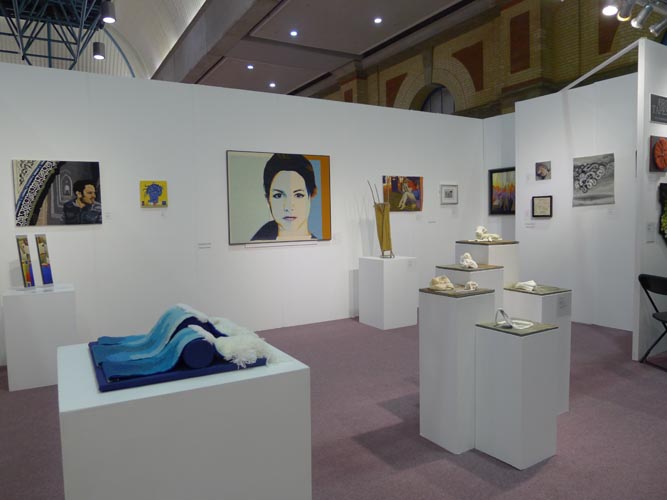
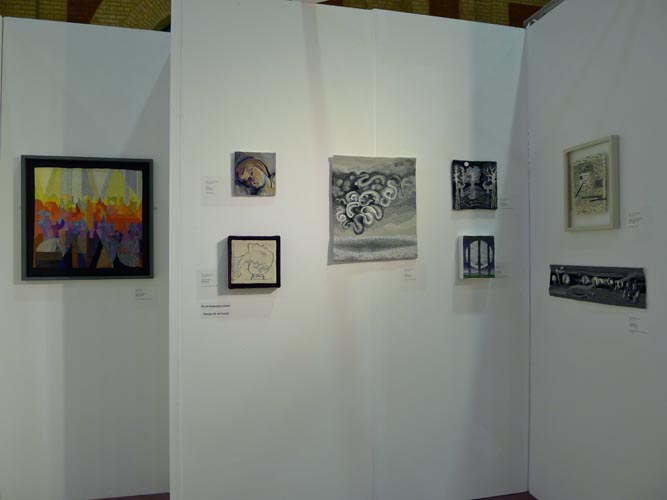

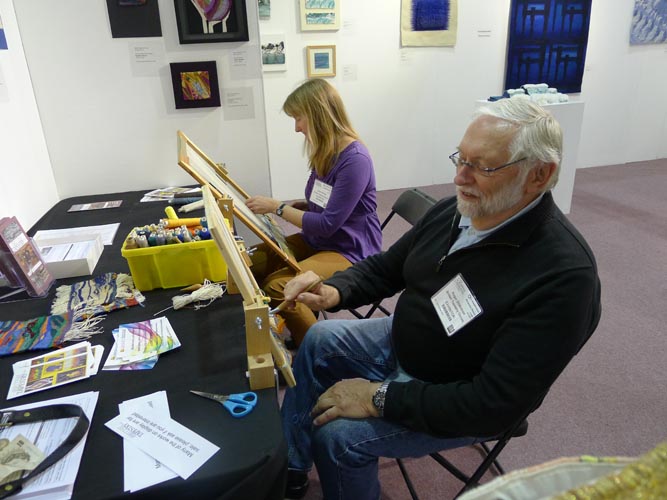
BTG members Jackie Bennett and Roger Dickinson demonstrating
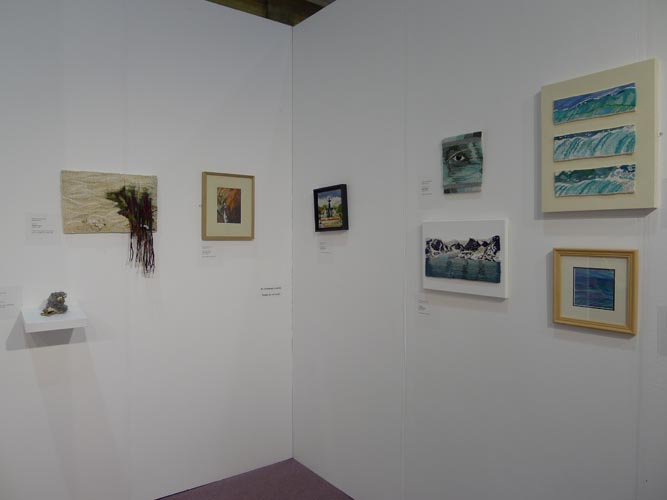
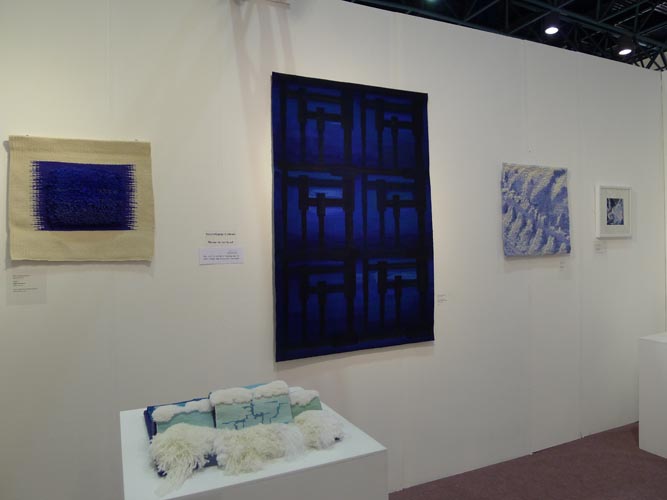
For more detailed pictures of individual pieces, see the Woven Art ’14 online catalogue.
24th May 2014 until 13th July 2014
Nuneaton Art Gallery and Museum, Nuneaton, England
26th April 2014 until 14th December 2014
Howgill Gallery
Farfield Mill, Sedbergh, England
Scott Gallery
Hawick Museum, Hawick, Scotland
Group: Scotland (UK)
18th April 2014 until 27th April 2014
Mill House Gallery, Angmering, England
Group: South East of England (UK)
12th January 2013 until 23rd February 2013
Gracefield Arts Centre, Dumfries, Scotland
Group: National
Tapestry Mischief
Historic influences and contemporary mischief. Members of the British Tapestry Group explore the medium of tapestry taking historical tapestries as the starting point, showing new work, some fragments of historic tapestries and accompanying interpretive material. Taking any aspect of the original such as an image, pattern or use of colour, the weavers have created highly individual contemporary interpretations using sometimes radical methods, fibres and colours, challenging the conventional form and surface of tapestry and its historical role as a narrative medium.
5th August 2011 until 23rd October 2011
The Stables Gallery, London, England
Group: National
7th June 2008 until 28th September 2008
UK wide
Group: National
Tapestry 08 Halifax
Bankfield Museum
Halifax, England
Dean Clough Gallery
Halifax, England
Tapestry 08 was developed by BTG, and funded by the Arts Council, to be a comprehensive exhibition of contemporary work by British tapestry weavers.
Tapestry 08 was much more than an exhibition. Demonstration days, seminars and a National Conference were held to encourage dialogue between practitioners.
Read a report below:
Tapestry 08 was developed by BTG, and funded by the Arts Council, to be a comprehensive exhibition of contemporary work by British tapestry weavers. This was long overdue, as the last overview of British tapestry weaving, The British Tapestry Trienniale 2, was in 1998 at the Harley Gallery at Wellbeck.
Tapestry 08 was much more than an exhibition. The tapestry weavers developing activities for Tapestry 08 were concerned that perceptions of the medium were tied to connotations of the historical. Outreach work with schools and young people, with students and the general public needed incorporating into the event to raise awareness of contemporary tapestry weaving. Demonstration days, seminars and a National Conference were held to encourage dialogue between practitioners.
Review:
Tapestry 08 was developed by BTG, and funded by the Arts Council, to be a comprehensive exhibition of contemporary work by British tapestry weavers. Tapestry 08 was much more than an exhibition. Demonstration days, seminars and a National Conference were held to encourage dialogue between practitioners.
The Exhibition:
The range of scale, from the miniature, as in Joyce Coulton’s ‘sketchbook’ pieces, to the monumental ‘Arizona Quartet’ by Shirley Ross, was exciting and, whilst some pieces were extremely bold in colour and composition, such as Fiona Rutherford’s ‘Up and Up’ or Kirsten Glasbrook’s ‘Soul Birds’, others are infinitely subtle. A piece by Soon Yul Kang, ‘Meditation’ slowly reveals its subtleties rewarding close scrutiny and time to enter into its atmospheric and inner world. Other pieces similarly reward close attention, the iridescent, twilight visions of Elin Huws and the shimmering, shifting landscapes in Beryl Hammill’s ‘Weaving the Country; Pilbara’.
Together these works exemplify the potential and diversity of tapestry weaving, from the hugely complex sculptural cell structures of Margaret Crowther’s ‘Fandango’ to the restrained geometry of ‘Thin Ice’ by Hillu Liebelt or the subtly vicious piece by Alastair Duncan, seductive at a distance, deeply disturbing at close quarters (incorporating barbed wire – see below). The work is accessible for both those who have never seen tapestries to those familiar with or immersed in the process of creating them.
The qualities of colour and surface in tapestries attract – warp and weft impose structure which harmonises compositional elements, be they representational, illusionistic or abstract in content. Viga Slater’s ‘Broadband’ pieces play upon indigo, cerise and viridian, painstakingly evoking painterly strokes and mottled stripes. Jilly Edwards’ fascinating double sided, tiny compositions on a continuous roll record her responses to changing seasons, use colour and light which mutate from the soft greens and pale yellows through to near monochrome and midnight hues spiked by tiny lines and spots of pinks and vermilions. These pieces are quiet but intense distillations of visual experience. It is the commitment and time embedded in these works which make a sustained visit so worthwhile. At the Bankfield Museum the second part of the exhibition presented an equally varied range of pieces including the representationally complex ‘My September 11’ by Christopher Sanders, referencing twenty first century technology and institutions, mass media and advertising, all painstakingly woven – a rich contradiction in every way, pushing the medium to express the transient and banal. This very large piece is in stark contrast to the beautifully subtle, near abstract ‘October Landscape’ by Joan Baxter with its hazy undulating bands of colour suggestive of windblown moorland and watery horizons.
This was flanked by other sensitive atmospheric pieces, Ros Bryant’s ‘Furthest Ebb’ and Sallie Tyszko’s ‘Island of 3 Stones’ both evoke beach and early morning light in very different ways, the latter incorporating fragments of driftwood which hold a warp woven with mica and monofilament suggesting floating jetsam and reflections.
Tapestry 08 considered how we present tapestry and what informs the making process, both conceptually and practically, to create new, stimulating work for the 21st century. Several works challenged the surface and form of conventional tapestry and question tapestry as ‘woven painting’. Non-traditional materials are incorporated and relief structures are created, moving some pieces towards the sculptural.
Other works articulate concepts and ideas, focusing on subject material that references contemporary culture whilst remaining true to the historical role of tapestry as a narrative medium. The exhibition signalled how tapestry weaving may develop.
Several pieces showed that traditional notions of narrative sequence can be disrupted, re-ordered and re-considered and the conventional role of tapestry as a direct woven interpretation of an image can be challenged.
Tapestry 08 Exhibition Review
Sonja Andrew, Lecturer in Textiles, University of Manchester
Ann Seabourne, painter
1st July 2006 until 15th July 2006
Hebden Bridge, West Yorkshire, England
Group: National
Tapestry Today
The inaugural exhibition for the British Tapestry Group, showing the work of 31 invited tapestry weavers from all over Britain and representing a wide cross-section of work being produced today. The tapestries have a diverse subject matter and the scale varies from small jewel-like weavings to large dramatic pieces. Uniting the artists is their overwhelming fascination and excitement with the weaving process and the use of yarns.

